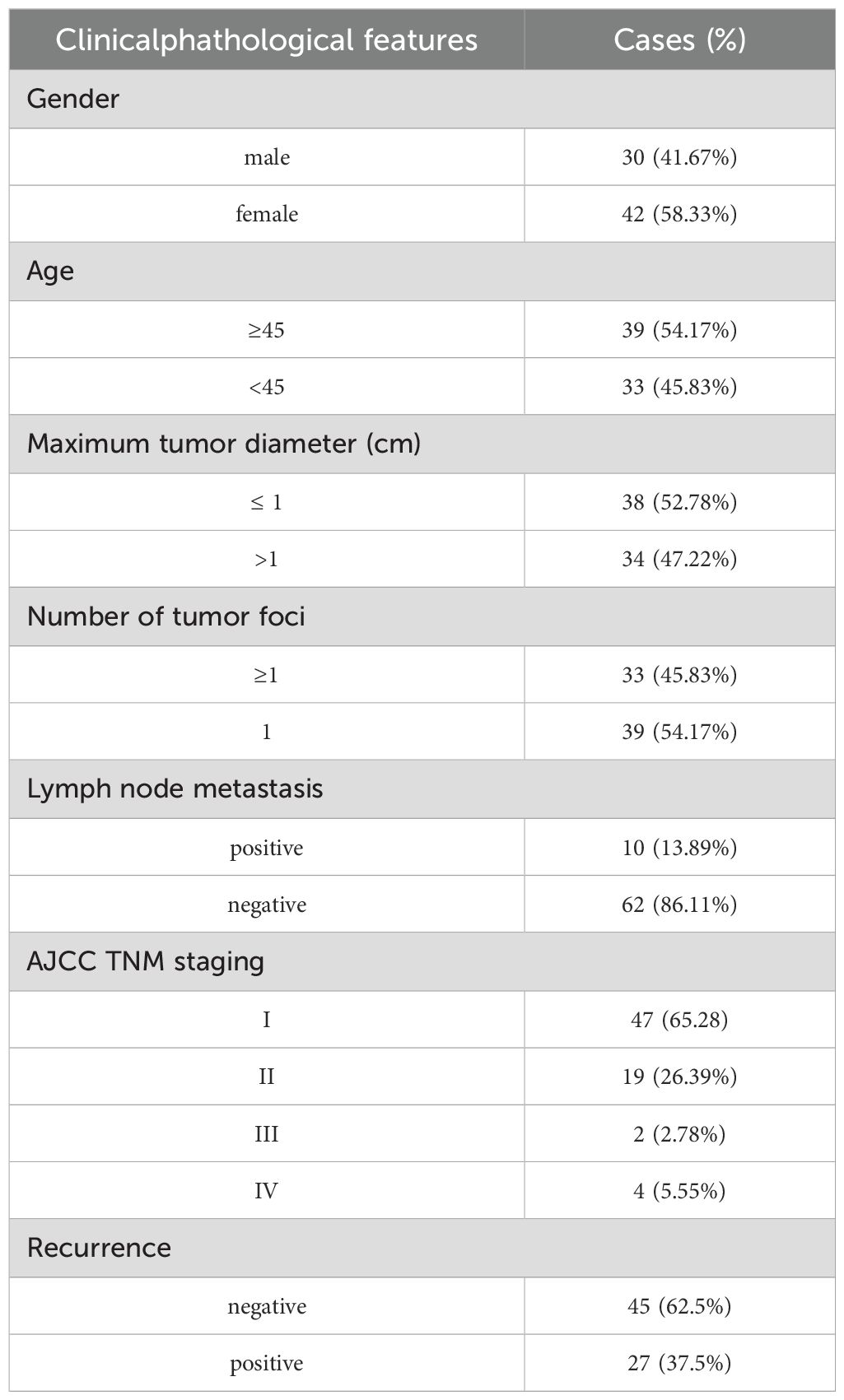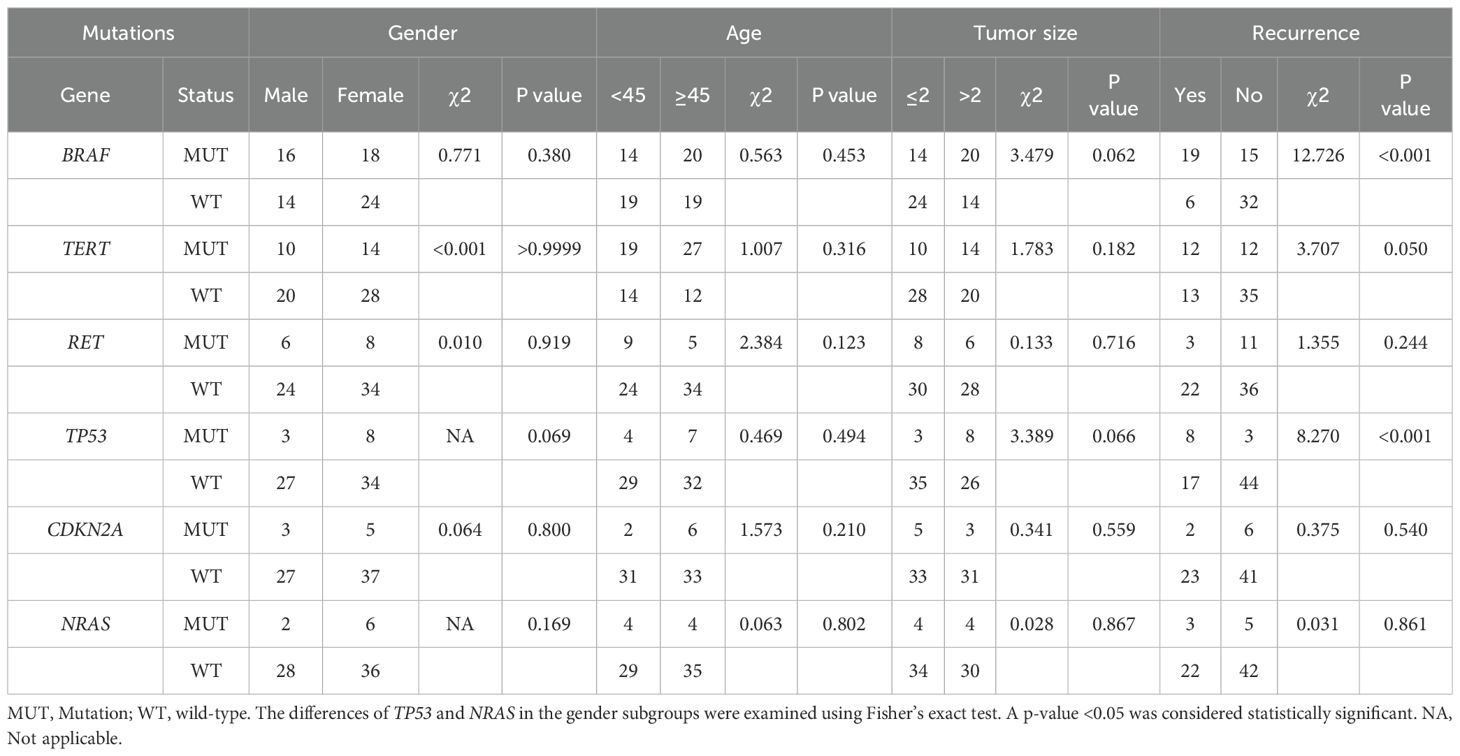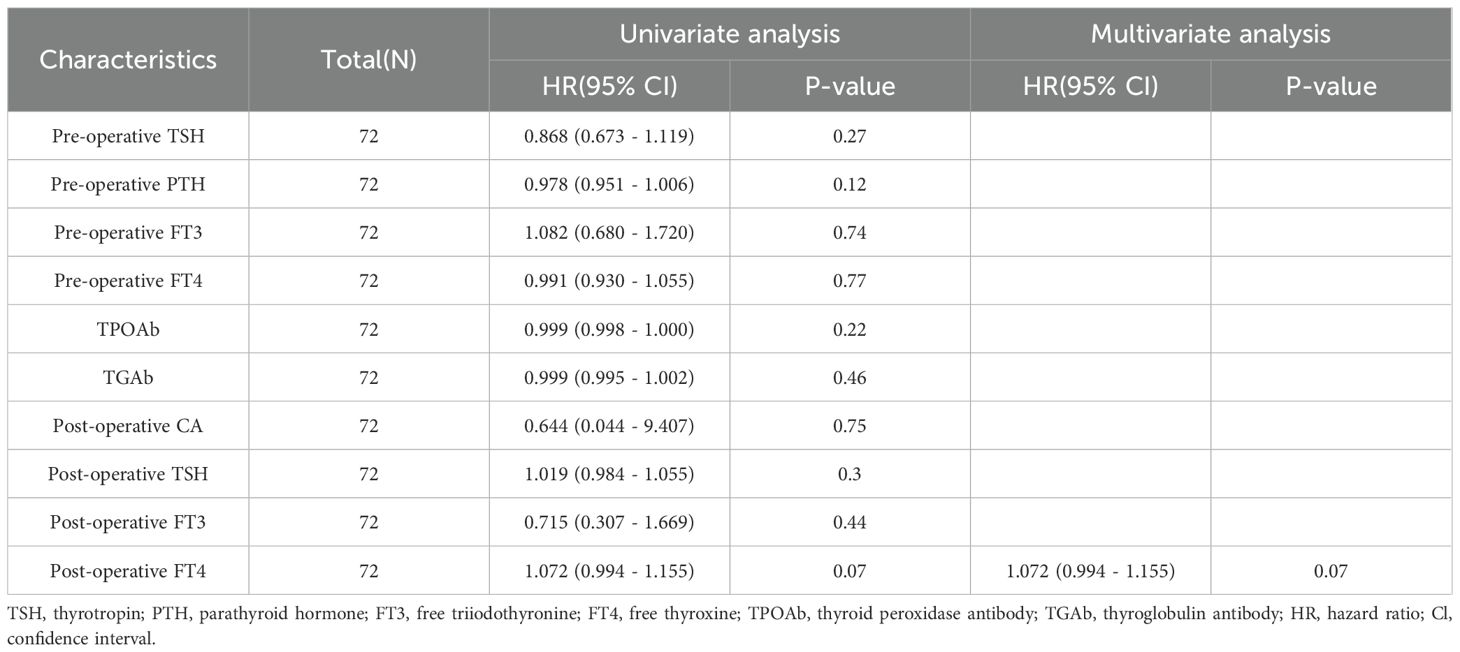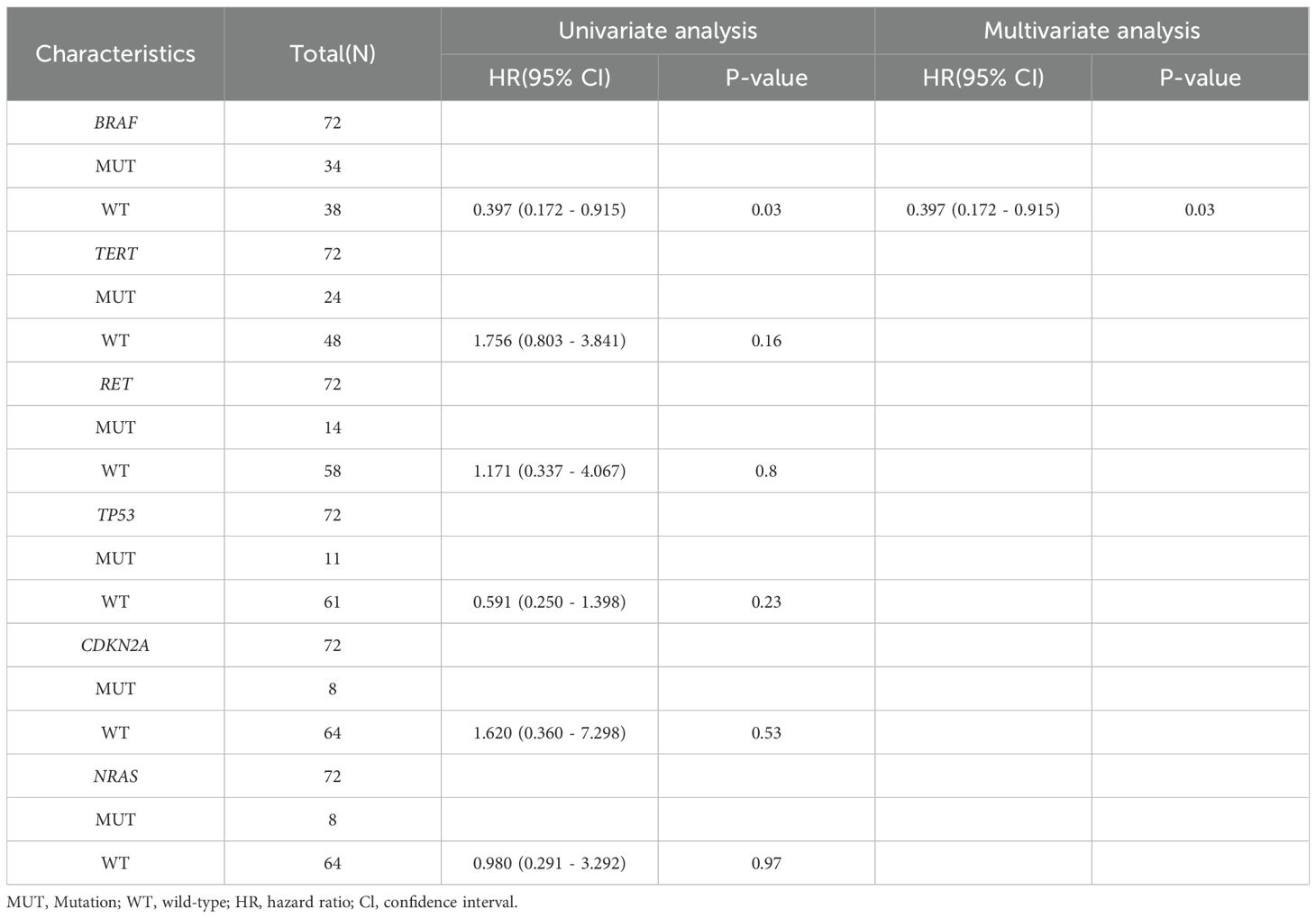- 1The Operation Room, Shengjing Hospital of China Medical University, Shenyang, China
- 2Department of the Seventh General Surgery, The Fourth Affiliated Hospital of China Medical University, Shenyang, China
Background: Papillary thyroid carcinoma (PTC) requires improved risk stratification through molecular profiling, yet how mutation interactions shape clinical outcomes remains poorly defined.
Methods: This single-center retrospective study analyzed 72 PTC cases using next-generation sequencing to characterize mutation patterns and pathway evolution, with validation against The Cancer Genome Atlas datasets.
Results: We identified three key molecular features: BRAF mutations (47.2%) predicted recurrence risk (p < 0.001), TP53 mutations (15.3%) were more prevalent in advanced thyroid cancers, and mutual exclusivity between BRAF and RET/NRAS mutations (p < 0.01), defining distinct oncogenic pathways. Paradoxically, BRAF mutations correlated with survival improvement (hazard ratio = 0.397), challenging conventional prognostic models. Pathway analysis revealed a potential shift from MAPK dominance in PTC to PI3K/NOTCH activation in advanced thyroid cancers, suggesting targetable vulnerabilities for mTOR inhibitors.
Conclusion: By integrating BRAF/TP53 status with conventional staging, we establish a mutation-guided framework that may refine risk prediction and inform treatment strategies, bridging molecular heterogeneity with clinical decision-making. This work provides insights for personalizing thyroid cancer management.
1 Introduction
Thyroid cancer is the most common endocrine malignancy, accounting for 3%–4% of all cancer diagnoses globally (1). Over the past few decades, its incidence has steadily increased, making it the fastest-growing solid tumor worldwide (2). In China, cases have surged by 289.6% from 1990 to 2019, particularly among individuals aged 15–49 (3). Papillary thyroid carcinoma (PTC), representing approximately 84% of thyroid malignancies, typically demonstrates favorable outcomes. However, significant challenges persist in predicting recurrence and personalizing treatment strategies. Current prognostic models, which predominantly rely on clinical parameters such as age, tumor size, and histological characteristics, remain limited by their inability to adequately account for the molecular complexity of thyroid cancer pathogenesis (4). The genes BRAF, TP53, and TERT play critical roles in the molecular pathogenesis of thyroid cancer. Mutations in the BRAF gene, particularly the V600E variant, occur in up to 60% of PTC cases and are associated with aggressive tumor features and increased recurrence risk, contributing to tumor initiation and progression through aberrant activation of the MAPK signaling cascade (5). In contrast, TP53 mutations, which disrupt the function of the p53 tumor suppressor protein and diminish cell cycle and DNA repair mechanisms, are more commonly found in poorly differentiated thyroid carcinoma (PDTC) or anaplastic thyroid carcinomas (ATC) and are strongly associated with adverse clinical outcomes (6). TERT promoter mutations upregulate telomerase activity, enabling cancer cells to bypass senescence and promoting unlimited cell division (7). Notably, TERT promoter mutations often co-occur with BRAF mutations, further exacerbate this risk and are linked to lower overall survival rates across various histological subtypes of thyroid cancer (8). Other mutations, such as those in RAS and RET, also play crucial roles in the pathogenesis of various thyroid cancer subtypes, affecting their clinical behavior and therapeutic responses (9). Therefore, integrating genetic data with clinical characteristics is needed to enhance patient outcomes by improving histology-based risk stratification and informing treatment decisions (10).
Despite advancements in genomic profiling, several gaps remain in understanding how different genetic mutations interact and collectively impact disease progression. Additionally, reliable biomarkers for accurately predicting patient outcomes are still lacking (11). These challenges hinder the translation of genetic findings into clinical practice and the development of tailored treatments based on individual genetic profiles.
To address these knowledge gaps, we conducted an integrated analysis of genetic mutations and clinical outcomes in patients with PTC. The primary objective was to explore novel associations between specific mutations and clinical outcomes, including recurrence and survival. By examining these relationships, our findings aim to inform the development of more precise prognostic tools and guide future research on personalized treatment strategies in PTC.
2 Materials and methods
2.1 Study subjects and eligibility criteria
Papillary thyroid cancer patients who underwent surgical treatment at the Department of the Seventh General Surgery, The Fourth Affiliated Hospital of China Medical University, between January 2013 and October 2019, were selected for this study. Ethical approval was granted by the institutional Ethics Committee of the Fourth Affiliated Hospital of China Medical University, ensuring adherence to the principles of the Declaration of Helsinki. Informed consent was obtained from all participants prior to inclusion in the study.
After rigorous screening, 72 patients with identified gene mutations who had undergone surgical treatment were included for in-depth analysis. Postoperatively, patients received routine thyroid-stimulating hormone (TSH) suppression therapy to control disease progression and reduce the risk of recurrence. Additionally, in accordance with the risk stratification criteria outlined in the American Thyroid Association guidelines (12), some patients received radioactive iodine (131I) therapy. This comprehensive treatment approach was designed to provide optimal therapeutic outcomes and ensure the accuracy of the data used in the study.
Patients were included based on the following strict criteria: newly diagnosed with thyroid cancer and untreated with radioactive iodine therapy (131I), radiofrequency ablation, or any other adjunctive therapies; underwent total or subtotal thyroidectomy with postoperative pathological confirmation of thyroid cancer; complete data accessible through the electronic medical record system; and aged between 18 and 84 years. Exclusion criteria were: incomplete preoperative or postoperative clinical records; presence of other malignancies; severe chronic diseases such as hypertension, heart disease, diabetes, or other significant organic diseases; non-adherence to standardized follow-up treatment protocols after discharge; unclear or disputed pathological diagnosis of thyroid cancer; absence of next-generation sequencing (NGS) for gene mutation detection; cases confirmed as metastatic, benign, indeterminate, borderline, or in situ thyroid cancer; endocrine-related disorders; and psychiatric illnesses.
2.2 Data collection
General patient information, including age and gender, was collected. Clinical presentation details, such as symptoms at diagnosis and their duration, were documented, along with thyroid function test results [(TSH; parathyroid hormone (PTH); free triiodothyronine (FT3); free thyroxine (FT4); thyroid peroxidase antibody (TPOAb); thyroglobulin antibody (TGAb)]. Details of surgical methods, the extent of lymph node dissection, and any intraoperative or postoperative complications were recorded. Pathological data, including maximum tumor diameter, presence of central or lateral lymph node metastasis, bilateral involvement, and multifocal lesions, were collected. Pathological staging was conducted according to the 8th edition of the American Joint Committee on Cancer (AJCC) staging system (13).
The follow-up period ranged from 22 to 121 months, with a median follow-up time of 55.5 months. During follow-up, key information such as postoperative 131I treatment, regular thyroid function tests, ultrasound examinations, and recurrence time was collected. The last telephone follow-up was conducted on November 1, 2023. The results of gene mutation detection obtained through NGS sequencing were also collected.
2.3 Criteria for recurrence
Recurrence was diagnosed based on the detection of new nodules or masses in the thyroid bed or neck region through high-resolution neck ultrasound, computed tomography (CT), or magnetic resonance imaging (MRI), exhibiting typical characteristics of thyroid cancer, such as irregular shape, heterogeneous echogenicity, and indistinct margins. Suspicious nodules or masses identified through imaging were subjected to fine-needle aspiration (FNA) for cytological or pathological examination. A significant increase in serum thyroglobulin (Tg) levels (>10 ng/mL measured by immunoassay with functional sensitivity ≤0.1 ng/mL) served as a biochemical indicator of recurrence. To minimize TgAb interference, all Tg measurements were concurrently tested for TgAb using electrochemiluminescence immunoassay (ECLIA). Cases with TgAb positivity (>40 IU/mL) were excluded from Tg-based recurrence assessment (14). For TgAb-negative or low-TgAb cases (<40 IU/mL), elevated Tg levels were considered clinically significant. Additionally, abnormal elevations in tumor markers (e.g., calcitonin for medullary carcinoma) or discrepant Tg/TgAb trends (rising Tg with stable/declining TgAb) were integrated into recurrence evaluation.
2.4 Sample preparation, DNA extraction, and sequencing library preparation
Formalin-fixed paraffin-embedded (FFPE) tissue specimens from all patients were subjected to NGS by Nanjing Geneseeq Technology Inc. Genomic DNA was extracted using the QIAamp DNA FFPE Tissue Kit (Qiagen, Germany) following the manufacturer’s instructions. Sequencing libraries were prepared using the KAPA Hyper Prep Kit (KAPA Biosystems, USA). Custom xGen Lockdown probes (Integrated DNA Technologies, USA) were used for hybrid capture targeting 437 tumor-related genes (GeneseeqPrime™ Pan-cancer gene panels; Geneseeq Technology Inc., China).
Hybridization reactions were performed using Dynabeads M-270 (Life Technologies, USA) and the xGen Lockdown Hybridization and Wash Kit (Integrated DNA Technologies, USA) according to the manufacturer’s protocol. The captured libraries were amplified by polymerase chain reaction (PCR) using Illumina p5 (5′-AAT GAT ACG GCG ACC ACC GA-3′) and p7 primers (5′-CAA GCA GAA GAC GGC ATA CGA GAT-3′) in KAPA HiFi HotStart ReadyMix (KAPA Biosystems, USA), followed by purification with Agencourt AMPure XP beads (Beckman Coulter, USA). Library quantification was performed using quantitative PCR (qPCR) with the KAPA Library Quantification Kit (KAPA Biosystems, USA). Library fragment size was determined using the Bioanalyzer 2100 (Agilent Technologies, USA).
Target-enriched libraries were sequenced on the HiSeq 4000 NGS platform (Illumina, USA) according to the manufacturer’s instructions. The average coverage sequencing depth for FFPE tissue samples was 1000×.
2.5 Sequencing data analysis
Quality control of the raw sequencing data was performed using Trimmomatic version 0.39 (15). Sequencing adapters and low-quality bases (Phred score <20) were trimmed from the reads, and reads shorter than 36 bp after trimming were discarded. Reads containing ambiguous bases (N bases) were removed. High-quality cleaned reads were aligned to the reference human genome (hg19/GRCh37) using the Burrows-Wheeler Aligner (BWA) MEM algorithm version 0.7.18 (16) with default parameters.
Post-alignment processing was conducted using the Genome Analysis Toolkit (GATK) version 4.1.0.0 (17). This included marking duplicates using Picard tools (version 2.18.14), realignment around indels, and base quality score recalibration. Data normalization and quality control measures were applied to ensure accurate variant calling, including assessment of sequencing depth and uniformity, mapping quality, and duplication rates.
Somatic mutations, including single nucleotide variants (SNVs) and small insertions and deletions (indels), were identified using MuTect2 (GATK version 4.1.0.0) (18) and VarScan2 version 2.4.2 (18) with default parameters. Variants were filtered based on quality scores, read depth, and strand bias. The variants were annotated using ANNOVAR software version 2018Apr16 (19) to identify known and novel mutations, determine their functional effects, and compare them against various databases such as dbSNP (build 151), 1000 Genomes Project, COSMIC v91, and ClinVar.
Copy number variations (CNVs) were detected using CNVkit version 0.9.6 (20), and structural variants (SVs) were identified using Manta version 1.6.0 (21). CNVkit analysis was performed using a reference built from pooled normal samples, and thresholds for copy number gains and losses were set according to standard guidelines. Variants were further filtered to exclude common polymorphisms (allele frequency >1% in the 1000 Genomes Project or ExAC databases) and those with low allele frequencies (<5%).
Pathway enrichment analyses were conducted using the Kyoto Encyclopedia of Genes and Genomes (KEGG) release 91.0 (22) and Reactome database version 70 (23) to assess the functional impact of the identified mutations. The potential clinical significance of the detected mutations was evaluated based on their presence in cancer-related genes and pathways, as well as their known associations with thyroid cancer prognosis and treatment response (24).
2.6 Comprehensive analysis of large-scale thyroid cancer genomics
An integrative analysis of mutations exceeding 10% prevalence in the PTC cohort, including BRAF, TERT, RET, TP53, CDKN2A, and NRAS, was performed using cBioPortal (https://www.cbioportal.org/) (25). The datasets Papillary Thyroid Carcinoma (PTC, TCGA, Cell 2014) and Poorly-Differentiated and Anaplastic Thyroid Cancers (PDTC/ATC, MSK, JCI 2016) (26) were selected. The mutual exclusivity and co-occurrence of these mutations and their correlation with survival time, were assessed according to cBioPortal’s instructions. The curated thyroid cancer pathways invloved the mutations were outlined using PathwayMapper 2.3 (https://www.pathwaymapper.org/) (27). The functional enrichment was analyzed and visualized using ShinyGO 0.81 (https://bioinformatics.sdstate.edu/go/) (28) and STRING 12.0 (https://string-db.org/) (29).
2.7 Statistical analysis
Data analysis was performed using SPSS statistical software version 22.0 (IBM Corp., USA). Continuous variables were expressed as mean ± standard deviation (mean ± SD) and compared using independent-samples t-tests. Categorical variables were expressed as frequencies and percentages (%) and compared using Chi-square tests or Fisher’s exact test where appropriate. Univariate and multivariate Cox proportional hazards regression analyses were employed to evaluate the associations between clinical characteristics, genetic mutations, and prognosis. Hazard ratios (HRs) with 95% confidence intervals (CIs) were calculated. Kaplan-Meier survival curves were generated to assess relapse-free survival (RFS), and differences were evaluated using the log-rank test. In all statistical analyses, a p-value <0.05 was considered statistically significant.
Due to the retrospective nature of the study and incomplete clinical documentation, data regarding adjuvant radioactive iodine (RAI) therapy and the completeness of surgical resection were not consistently available and were therefore excluded from the multivariate models. Although all patients underwent curative thyroidectomy, detailed surgical margin status and adjuvant treatment records were not uniformly reported.
3 Results
3.1 Mutation profiles across the PTC cohort and TCGA datasets
Thyroid cancer exhibits substantial molecular heterogeneity, and understanding the genetic landscape of Papillary Thyroid Carcinoma (PTC) is critical for improving diagnostic and therapeutic strategies. To characterize the mutational profiles, we analyzed genetic alterations in 72 PTC cases and compared their mutation distributions across different clinical subgroups and The Cancer Genome Atlas (TCGA) datasets. The clinicopathological characteristics of the cohort are summarized in Table 1, showing a balanced distribution of demographic and clinical parameters, with 58.3% of cases being female (42/72), 54.2% aged ≥45 years (39/72), and 37.5% experiencing recurrence (27/72). The mutational landscape of our cohort (Figure 1) revealed that BRAF was the most frequently mutated gene (47.2%), followed by TERT (33.3%), RET (19.4%), TP53 (15.3%), CDKN2A (11.1%), and NRAS (11.1%). The mutation burden varied among tumors, with some harboring only a single driver mutation, while others displayed multiple co-occurring alterations. Further subgroup analyses revealed differential mutation prevalence across clinical categories (Figure 2). BRAF mutations occurred in 53.3% of males versus 42.9% of females, 42.4% of patients <45 years versus 51.3% ≥45 years, and 36.8% of tumors ≤1 cm versus 58.8% >1 cm. Similarly, TERT mutations showed varying prevalence by age (27.3% <45 years vs. 38.5% ≥45 years) and tumor size (26.3% ≤1 cm vs. 41.2% >1 cm). RET mutations were more frequent in younger patients (27.3% vs. 12.8%), while TP53 mutations increased with age (10% vs. 19%) and larger tumor size (7.9% vs. 23.5%). However, these differences were not statistically significant (Table 2).
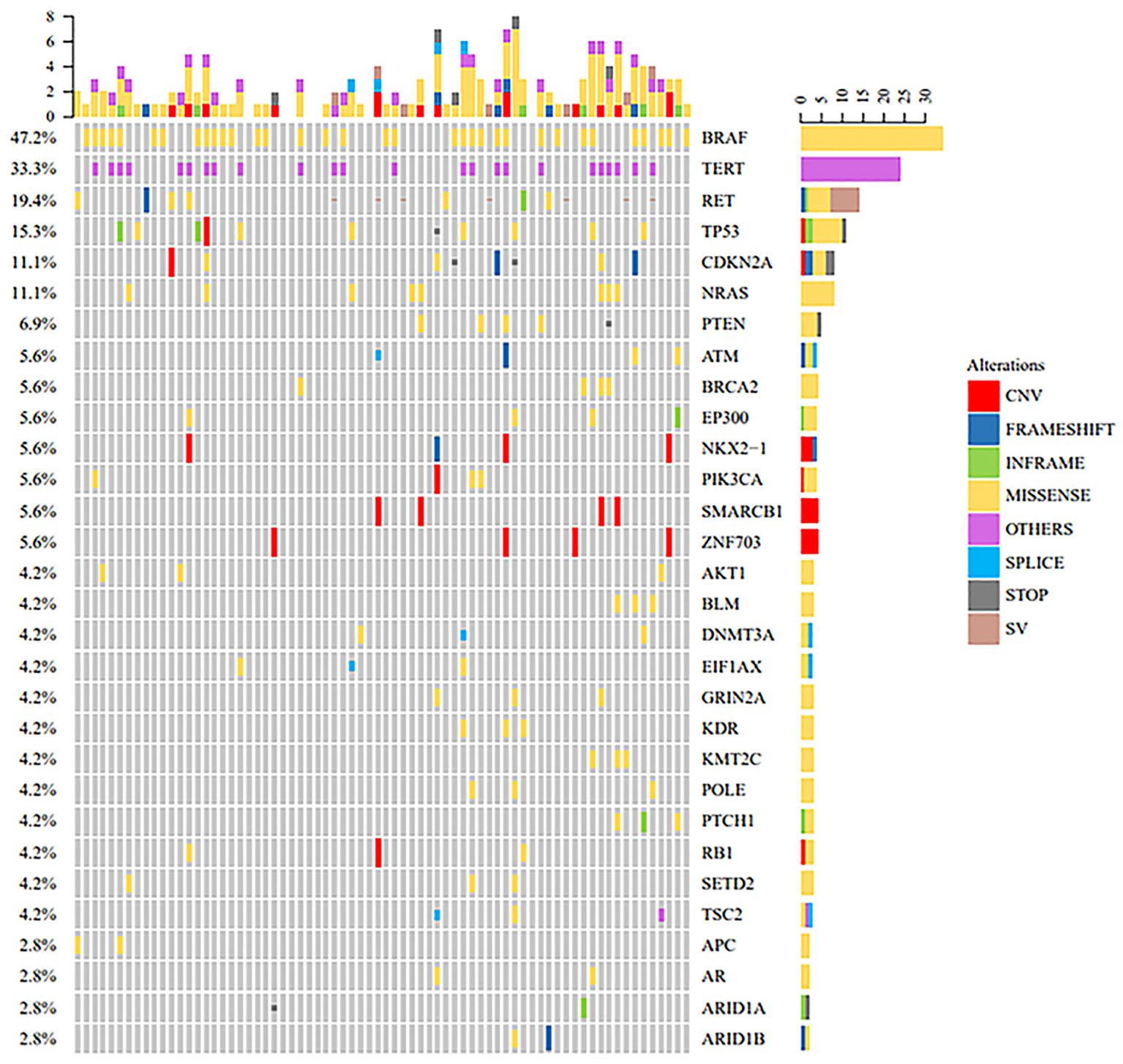
Figure 1. Mutation landscape of 72 papillary thyroid cancer cases. This oncoprint diagram presents the mutation profiles of the papillary thyroid carcinoma (PTC) cohort, highlighting the most recurrently mutated genes. Each column represents an individual case, while rows represent genes. Different colors indicate specific mutation types. The top bar graph illustrates the mutation burden per sample, and the right panel summarizes the mutation prevalence of each gene.
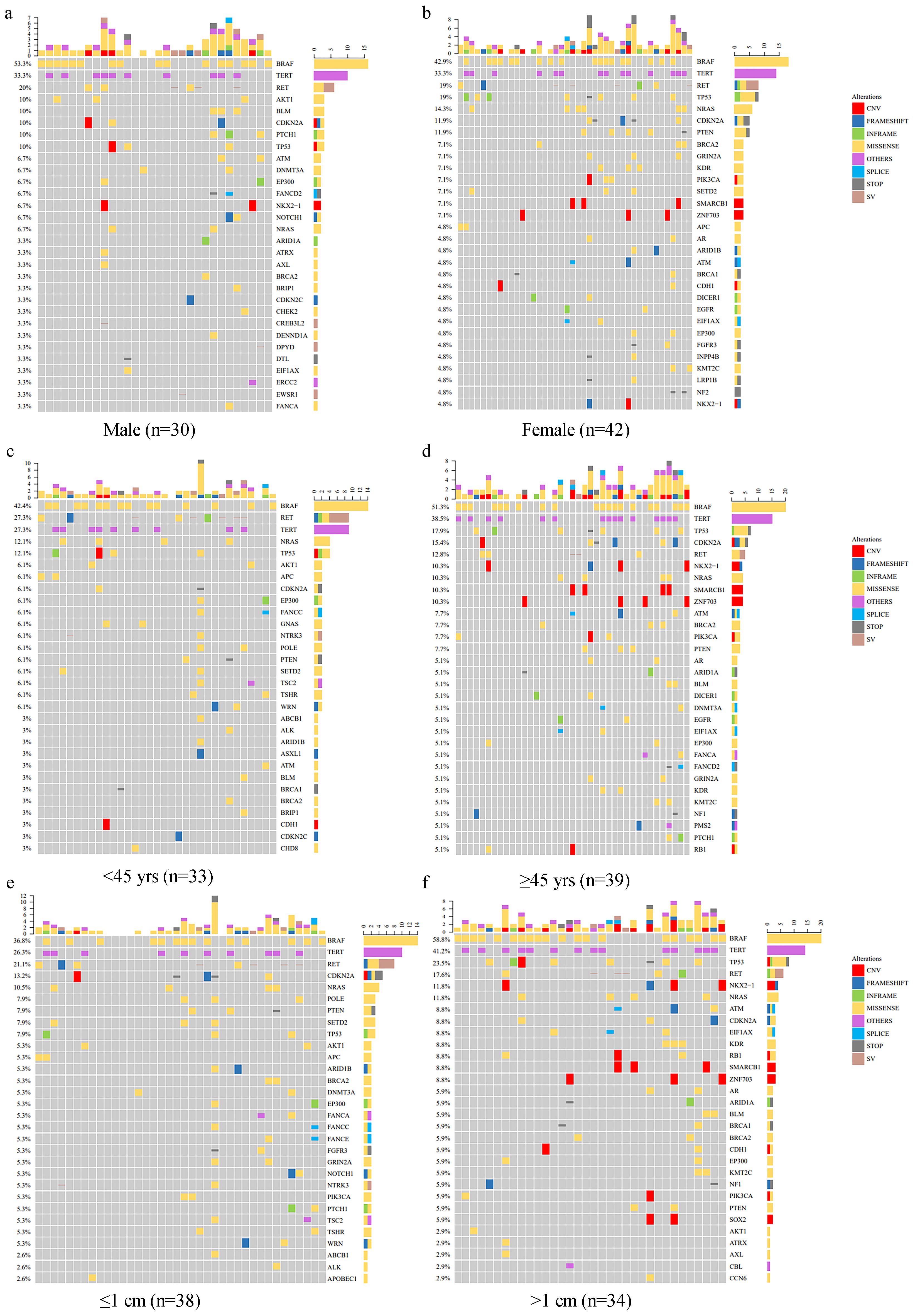
Figure 2. Mutation profiles of PTC clinical subgroups. Oncoprint diagrams showing the mutation profiles of PTC cases stratified by clinical subgroups, including: (a) Male; (b) Female; (c) Age < 45 years; (d) Age ≥ 45 years; (e) Tumor size ≤ 1 cm; (f) Tumor size > 1 cm. Each panel illustrates the mutational landscape per subgroup, with the most frequent mutations displayed in descending order of frequency. Different colors represent distinct mutation types.
Notably, recurrent cases demonstrated substantially higher BRAF (70.4% vs. 33.3%) and TERT (44.4% vs. 26.7%) mutation frequencies compared to non-recurrent cases, but lower RET (11.1% vs. 24.4%) and TP53 (29.6% vs. 6.7%) prevalence (Figure 3). Both BRAF and TP53 mutations showed strong correlations with recurrence (p < 0.001), underscoring their prognostic relevance. Although TERT mutations did not reach statistical significance (p = 0.050), the observed trend warrants further investigation. No significant associations were observed for RET, CDKN2A, or NRAS mutations.
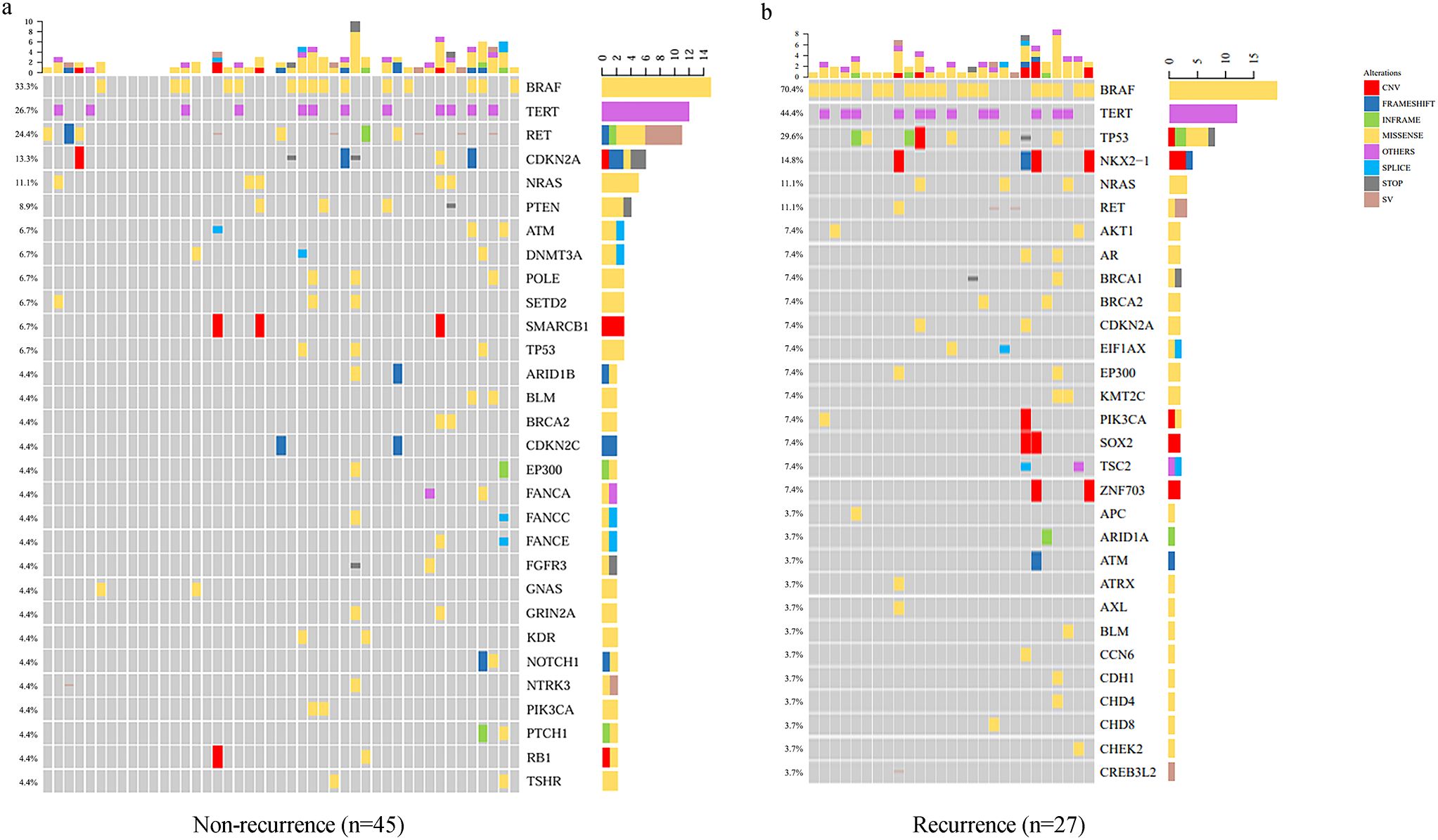
Figure 3. Mutation profiles in recurrent and non-recurrent PTC patients. Oncoprint diagrams comparing the mutational landscape of non-recurrent and recurrent PTC cases: (a) Non-recurrent PTC cases; (b) Recurrent PTC cases. Key differences in mutation prevalence and distribution are highlighted, with BRAF, TERT, and TP53 mutations observed more frequently in recurrent cases.
These findings align with the observed mutation distributions across clinical subgroups (Figures 1–3), reinforcing the notion that BRAF and TP53 mutations are key contributors to recurrence risk in PTC. The lack of significant associations for other mutations, such as NRAS and CDKN2A, suggests that their roles in PTC pathogenesis may be context-dependent or influenced by additional molecular alterations. By comparing our cohort with TCGA datasets (Supplementary Figure 1), we observed that the prevalence of BRAF mutations was relatively consistent between our cohort (47.2%) and TCGA-PTC (50.0%), whereas TP53 mutations were significantly more frequent in TCGA-PDTC/ATC (28%) than in TCGA-PTC (0.8%) or our cohort (15.3%). This pattern highlights the potential role of TP53 in tumor dedifferentiation and progression to more aggressive thyroid cancer subtypes.
Collectively, these findings suggest that while BRAF mutations are central to PTC initiation, TP53 and TERT mutations may be more relevant in recurrence and disease progression. The distinct mutational landscapes observed in PDTC/ATC further indicate shifts in oncogenic pathways during thyroid cancer evolution, which will be examined in the next section through mutation correlation analysis.
3.2 Mutation correlations, protein-protein interactions, and pathway alterations in thyroid cancer
Analysis of mutation correlations in 72 papillary thyroid cancer (PTC) cases revealed distinct patterns of co-occurrence and mutual exclusivity. Significant co-mutations were identified between TP53 and EP300, NRAS and PTEN, as well as NRAS and BRCA2, suggesting potential cooperative oncogenic mechanisms. In contrast, BRAF mutations displayed mutual exclusivity with RET and NRAS mutations, reinforcing their distinct roles as alternative oncogenic drivers in PTC (Figure 4a). The interaction of the proteins were further investigated. A protein-protein interaction network highlighted interactions at the protein level (Figure 4b).
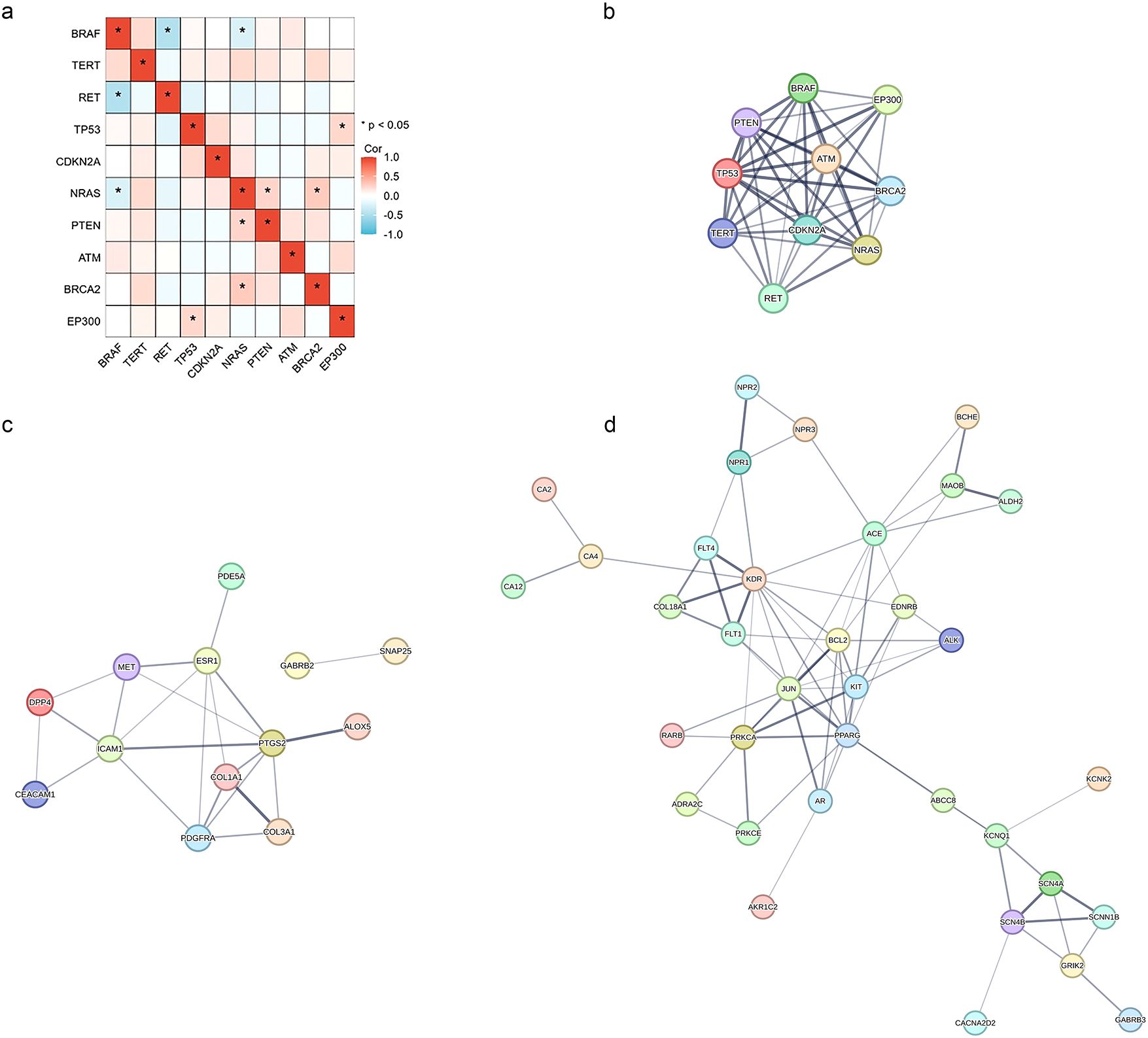
Figure 4. Mutation correlations and protein-protein interaction (PPI) networks in papillary thyroid cancer. This figure presents the mutation correlation matrix and PPI networks of key mutated genes and FDA-approved drug target genes in PTC and TCGA datasets: (a) Mutation correlation matrix of the top 10 frequently mutated genes in the 72 PTC cases. Significant co-occurrences are shown in red, while mutually exclusive relationships are in blue (p < 0.05). (b) PPI network of the top 10 frequent mutations in PTC, illustrating functional interactions among driver mutations. (c) PPI network of the upregulated FDA-approved drug target genes in TCGA datasets, highlighting oncogenic signaling pathways. (d) PPI network of the downregulated FDA-approved drug target genes in TCGA datasets, indicating loss of tumor suppressor functions. These findings suggest that various co-mutation patterns and drug target alterations may drive thyroid cancer progression and contribute to distinct therapeutic responses.
To validate these observations, mutation correlations were further examined in the TCGA-PTC and TCGA-PDTC/ATC datasets (Supplementary Tables 1, 2). The exclusivity of BRAF with RET and NRAS was consistently observed in TCGA-PTC, supporting its robustness across different cohorts. However, the co-mutations involving TP53, NRAS, PTEN, and BRCA2, which were evident in our dataset, were not observed in either TCGA-PTC or TCGA-PDTC/ATC. This discrepancy suggests that these alterations may be enriched in a subset of PTCs with specific clinicopathological characteristics. Additionally, BRAF-TERT co-occurrence was observed across all three datasets but did not reach statistical significance.
To gain further insights into the functional impact of these genetic alterations, we explored FDA-approved drug target genes affected by the five most frequent mutations in TCGA-PTC (Supplementary Table 3) and TCGA-PDTC/ATC (Supplementary Table 4), respectively. The identified drug target genes exhibited distinct expression patterns in each dataset, prompting further investigation into their functional interactions. The PPI network of upregulated drug target genes in both TCGA-PTC and TCGA-PDTC/ATC datasets (Figure 4c) revealed their clustering within oncogenic signaling pathways, indicating potential therapeutic vulnerabilities. Conversely, the PPI network of downregulated drug target genes in both datasets (Figure 4d) demonstrated their involvement in tumor suppressor pathways, suggesting a loss of tumor-suppressive functions. These findings highlight the relevance of mutation-driven alterations in drug target genes and their potential influence on therapeutic response.
Further comparative pathway analysis of the TCGA-PTC and TCGA-PDTC/ATC datasets underscored distinct differences in the activation of key oncogenic pathways (Supplementary Figure 2). PTC tumors generally retained functional TP53/CDKN2A signaling, which likely contributed to controlled tumor growth and more favorable outcomes. In contrast, PDTC/ATC exhibited frequent TP53 and CDKN2A mutations, promoting genomic instability, aggressive progression, and therapy resistance. Similarly, BRAF mutations were predominant in PTC, reinforcing well-differentiated tumor characteristics, whereas PDTC/ATC showed a transition toward NRAS-driven oncogenesis, associated with poorer differentiation and altered therapeutic responses.
In terms of cell cycle regulation, PTC tumors displayed minimal disruption of CDKN2A and RB1, preserving controlled proliferation. However, PDTC/ATC exhibited substantial deregulation of these pathways, leading to unchecked cell cycle progression and reduced sensitivity to checkpoint inhibitors. Moreover, PI3K pathway activation was relatively uncommon in PTC but frequently altered in PDTC/ATC, signifying a shift toward PI3K-driven survival mechanisms and increased resistance to targeted therapies. Lastly, NOTCH signaling remained largely intact in PTC, supporting differentiation programs, while PDTC/ATC demonstrated widespread NOTCH pathway disruption, favoring dedifferentiation, metastasis, and more aggressive disease progression.
In summary, these findings illustrate the molecular divergence between well-differentiated PTC and its more aggressive counterparts, PDTC and ATC. The identification of co-mutation patterns, pathway alterations, and drug target gene disruptions suggests distinct mechanisms driving tumor behavior and therapeutic responses. These insights may aid in refining personalized treatment strategies and identifying novel therapeutic targets for more aggressive thyroid cancer subtypes.
3.3 Association between clinicopathological features, mutations, and survival outcomes
Given the observed mutation correlations, protein-protein interactions, and pathway alterations in thyroid cancer, we next investigated their clinical implications by assessing the association between key genetic alterations and survival outcomes. Kaplan-Meier survival analysis was performed to evaluate the impact of clinicopathological and molecular features on relapse-free survival (RFS) in the 72 PTC cases. Older age (≥ 45 years), larger tumor size (> 1 cm), and advanced TNM stage (III+IV) were significantly associated with reduced RFS (p < 0.001, Figures 5a–c). Additionally, the presence of BRAF mutations showed a moderate but significant correlation with poorer prognosis (HR = 2.52, p = 0.030, Figure 5d).

Figure 5. Kaplan-Meier survival analysis of relapse-free survival (RFS) in PTC. Kaplan-Meier survival curves illustrating relapse-free survival (RFS) in 72 PTC cases based on clinicopathological and genetic characteristics: (a) Age group (< 45 vs. ≥ 45 years); (b) Tumor size (≤ 1 cm vs. > 1 cm); (c) TNM stage (I+II vs. III+IV); (d) Presence of BRAF mutation (Altered vs. Non-Altered). Hazard ratios (HR) and p-values are shown for each comparison. Older age, larger tumor size, and advanced stage are significantly associated with worse RFS (p < 0.001). BRAF mutation shows a moderate but significant impact on prognosis (p = 0.030).
To further investigate the independent prognostic value of clinicopathological variables, Cox regression analysis was conducted (Table 3). Both univariate and multivariate analyses confirmed that age ≥ 45 years, advanced stage (III/IV), and tumor size > 1 cm were significant predictors of poor survival. Among these, age and TNM stage were identified as independent prognostic factors, reaffirming their critical role in thyroid cancer progression.
In addition to standard clinicopathological parameters, we evaluated whether thyroid hormone markers influenced survival outcomes (Table 4). No statistically significant associations were observed between pre- and post-operative thyroid function markers (TSH, PTH, FT3, FT4, TPOAb, TGAb) and survival (all p > 0.05). Post-operative FT4 showed no statistically significant association with prognosis (p = 0.07), though the observed trend may warrant further investigation in larger cohorts.
To assess the prognostic impact of recurrent genetic mutations, we performed Cox regression analysis on key driver mutations (Table 5). Interestingly, BRAF mutations were associated with significantly better survival (HR = 0.397, p = 0.03), which contrasts with the previously observed correlation with recurrence risk. This discrepancy suggests that while BRAF mutations may contribute to initial disease progression, they do not necessarily portend worse long-term survival. In contrast, TERT, RET, TP53, CDKN2A, and NRAS mutations did not show significant associations with survival outcomes (all p > 0.05), indicating that their impact may be more context-dependent or influenced by additional molecular factors.
To further assess the prognostic relevance of driver mutations in different thyroid cancer subtypes, survival analyses were conducted in the TCGA datasets. Disease-free survival (DFS) analysis in TCGA-PTC did not reveal any significant associations between BRAF, NRAS, TERT, RET, PTEN, or BRCA2 mutations and DFS (Supplementary Figure 3). However, in TCGA-PDTC/ATC, mutations in BRAF, TERT, TP53, CDKN2A, and BRCA2 were significantly associated with poorer overall survival (OS) (Supplementary Figure 4). In contrast, RET, PTEN, ATM, and EP300 mutations did not demonstrate a significant impact on survival outcomes.
These findings highlight the differential prognostic roles of genetic alterations across thyroid cancer subtypes. While tumor size and TNM staging remain the strongest predictors of survival in PTC, BRAF mutations exhibit a complex role, contributing to recurrence risk but not necessarily leading to worse long-term outcomes. Meanwhile, in more aggressive forms of thyroid cancer, such as PDTC and ATC, TP53, CDKN2A, and BRCA2 mutations are key contributors to poor prognosis, underscoring their role in tumor progression and therapy resistance. These observations reinforce the importance of integrating molecular profiling with clinical risk factors to refine prognostic stratification and guide personalized treatment strategies.
4 Discussion
This study of 72 papillary thyroid carcinoma (PTC) cases delineates a molecular landscape dominated by recurrent BRAF (47.2%), TERT (33.3%), and TP53 (15.3%) mutations. BRAF and TP53 mutations were strongly associated with recurrence (p < 0.001). Although TERT mutations approached but did not reach statistical significance (p = 0.050), their potential role was further investigation. Mutation interaction analysis revealed mutual exclusivity between BRAF and RET/NRAS (p < 0.01), reflecting distinct oncogenic pathways, and co-occurrence of TP53 and EP300, suggesting chromatin remodeling defects in aggressive subtypes. Advanced TNM stage (HR = 13.03, p = 0.003) and tumor size (>1 cm) emerged as dominant prognostic factors, though BRAF paradoxically correlated with improved survival (HR = 0.397, p = 0.03). When contextualized against The Cancer Genome Atlas (TCGA) datasets, the elevated prevalence of TP53 in poorly differentiated (PDTC) and anaplastic thyroid cancer (ATC) (28% vs. 0.8% in TCGA-PTC) underscores its role in tumor dedifferentiation (10). These findings collectively position BRAF as a key initiator of PTC, while TERT and TP53 drive recurrence and progression, highlighting the associations between genetic alterations and clinical outcomes.
The high prevalence of BRAF V600E aligns with its established role in MAPK-driven tumorigenesis (30). However, its dual association—linked to recurrence risk but improved survival—raises critical questions. This discrepancy may reflect treatment biases, such as the potential for preferential use of targeted therapies in mutation-positive cases, which could confound survival outcomes. For instance, in radioiodine-refractory differentiated thyroid cancer (RAIR-DTC) patients treated with multi-kinase inhibitors (MKIs), those harboring the BRAF V600E mutation achieved better prognoses compared to patients with wild-type BRAF (31). Although we lack specific data on MKI use in our cohort, it is plausible that BRAF V600E-mutant patients were more likely to receive targeted therapies following recurrence, potentially contributing to improved survival by inhibiting MAPK signaling and other pathways involved in tumor progression. Another explanation could be the heterogeneity of BRAF mutations beyond the canonical V600E variant. While BRAF V600E is well-characterized and associated with aggressive tumor behavior and poorer outcomes, the clinical implications of non-V600E BRAF mutations (e.g., BRAF K601E and BRAF L597Q) remain poorly understood, with limited data on their prognostic and therapeutic relevance (32, 33). Furthermore, differences in post-recurrence management may also contribute to the observed survival benefit. BRAF V600E-mutant patients may have been more likely to receive aggressive treatment strategies following recurrence, such as repeat surgery, radiation therapy, or participation in clinical trials. However, due to the limitations of our retrospective study and the lack of comprehensive treatment data and subtype-specific information, we are unable to fully explain the paradoxical association between BRAF V600E mutation and survival. Future studies with larger cohorts and detailed treatment information are warranted to further explore this complex relationship.
In contrast, TERT mutations, despite their prevalence (33.3%), lacked a definitive association with recurrence (p = 0.050). This may be potentially due to cohort limitations, including the exclusion of PDTC/ATC subtypes where TERT is more prognostically impactful (34). Meanwhile, TP53’s intermediate prevalence (15.3%) bridges rates observed in differentiated (1%–3%) and anaplastic (80%) thyroid cancers (10), further supporting its established role as a key player in tumor progression and dedifferentiation. These observations underscore the need to interpret mutation profiles within both molecular and clinical contexts.
Mechanistically, the mutual exclusivity of BRAF with RET/NRAS, validated in TCGA-PTC, highlights divergent MAPK activation mechanisms. This biological dichotomy supports stratified therapeutic approaches: BRAF inhibitors for BRAF-mutant tumors versus RET inhibitors (e.g., selpercatinib) for RET-altered cases (35). Furthermore, the co-occurrence of TP53 and EP300 mutations suggests epigenetic dysregulation through chromatin remodeling defects (36), though functional studies are needed to confirm this hypothesis. Equally critical is the observed pathway evolution from MAPK dominance in PTC to PI3K/NOTCH activation in PDTC/ATC, which may explain the limited efficacy of BRAF inhibitors in advanced disease and underscores PI3K/mTOR inhibitors (e.g., everolimus) as promising therapeutic alternatives. These pathway-specific shifts emphasize the dynamic nature of thyroid cancer progression and the importance of tailoring therapies to molecular subtypes.
Clinically, TNM stage and tumor size remain the cornerstones of prognosis, but integrating BRAF and TP53 status could refine risk stratification. For instance, BRAF/TP53-mutant stage I/II cases may necessitate intensified surveillance or adjuvant therapy. The survival advantage associated with BRAF mutations challenges conventional paradigms and warrants prospective validation to disentangle treatment-related confounders. Equally noteworthy is the lack of prognostic value in postoperative thyroid function markers (TSH, FT3, FT4), which emphasizes the primacy of molecular profiling over biochemical parameters in recurrence prediction. This finding aligns with some studies but contrasts with others that have reported ambiguous relationships between thyroid hormone levels and cancer recurrence (37). Therapeutic strategies must evolve to reflect this molecular heterogeneity: combining BRAF/MEK inhibitors (e.g., dabrafenib/trametinib) with radioiodine sensitizers may enhance efficacy in localized PTC, while advanced PDTC/ATC—characterized by PI3K/NOTCH activation—could benefit from pathway-specific agents such as everolimus or crenigacestat (38). Clinical studies have shown that the mTOR inhibitor everolimus exhibits antitumor activity in advanced differentiated thyroid cancer, although mTOR pathway mutations do not reliably predict response (39). Everolimus may also benefit PI3K/mTOR/Akt-mutated ATC, but genomic profiling is not yet a standard tool for guiding treatment decisions in thyroid cancer (40). The pan-PI3K inhibitor buparlisib failed to demonstrate significant efficacy in advanced FTC and PDTC; however, the observed decrease in tumor growth rate suggests potential benefits from combining PI3K and MAPK pathway inhibitors (41). Other PI3K/mTOR inhibitors, such as copanlisib and alpelisib, are also under investigation (42). A phase 1b study of the NOTCH inhibitor crenigacestat combined with the dual PI3K/mTOR inhibitor LY3023414 showed poor tolerability and limited clinical activity in advanced solid tumors (43). Despite these challenges, other NOTCH inhibitors continue to be explored in preclinical and clinical settings. Ultimately, personalized treatment strategies based on the molecular profiles of individual tumors will be crucial for optimizing therapeutic outcomes in thyroid cancer.
Despite these insights, several limitations warrant consideration. The retrospective design and modest cohort size (n = 72) limit statistical power, especially for detecting significant associations involving less frequent mutations such as TP53 (15.3%) and CDKN2A (11.1%). These limitations may compromise the robustness of subgroup analyses and increase the risk of false negatives. Additionally, potential selection bias may exist, as evidenced by the slightly lower BRAF prevalence in our cohort compared to TCGA-PTC (47.2% vs. 50.0%).
Additionally, we acknowledge that treatment-related variables—such as adjuvant radioactive iodine (RAI) therapy, completeness of surgical resection, and other therapy types—can influence survival outcomes. However, due to the retrospective nature of our study and incomplete clinical documentation, these factors could not be included as covariates in our Cox regression analysis. Notably, all patients underwent radical thyroidectomy, which may help reduce variability in surgical management. Nonetheless, the absence of detailed treatment data limits our ability to fully account for potential confounding, and future prospective studies with comprehensive clinical annotation are warranted to clarify the impact of treatment modalities on prognosis.
Another limitation is the lack of subtype-specific data within our PTC cohort and the TCGA/MSK datasets. While PTC comprises various subtypes (diffuse sclerosing variant, tall cell variant, columnar cell variant, solid variant, and hobnail variant) with potentially distinct genetic profiles and clinical characteristics, our analysis was conducted on the overall PTC cohort given limited subtype-specific data. Future research should aim to incorporate subtype-specific analyses to provide a more nuanced understanding of the molecular mechanisms driving disease progression in different PTC subtypes.
Furthermore, the absence of functional validation precludes mechanistic validation of interactions such as NRAS-PTEN-BRCA2. Future research should prioritize multi-center prospective studies with standardized molecular profiling to validate BRAF’s dual prognostic role and clarify TERT’s subtype-dependent effects. Functional exploration of TP53-EP300 and NRAS-PTEN interactions is critical to unravel their roles in chromatin remodeling and therapy resistance. Concurrently, clinical trials testing PI3K/NOTCH inhibitors in PDTC/ATC could bridge mechanistic insights to therapeutic application. Finally, while the use of TCGA and MSK datasets for cross-validation strengthens the generalizability of our findings, it is important to acknowledge that differences in patient populations, data collection protocols, clinical annotations, and sequencing platforms between these external datasets and our own cohort may introduce batch effects or reflect underlying clinical heterogeneity. These factors could influence observed mutation frequencies and their associations with clinical outcomes. Therefore, caution is warranted when interpreting cross-dataset comparisons, and future efforts should prioritize harmonized data integration across multi-institutional cohorts.
In conclusion, this study contributes to the understanding of thyroid cancer by reinforcing the clinical relevance of BRAF, TERT, and TP53 in tumor initiation, recurrence, and progression, though further functional validation is needed. The mutual exclusivity of BRAF with RET/NRAS and its potential synergy with TERT underscore the complexity of mutation interactions in shaping tumor behavior. By integrating molecular profiling with conventional staging systems, clinicians may enhance the precision of risk stratification and tailor therapeutic strategies to individual molecular profiles. However, translational success hinges on validating these findings in larger cohorts and testing targeted therapies in rigorously designed trials. Such efforts will help advance precision oncology in thyroid cancer by validating mutation-informed strategies for risk stratification and therapeutic selection.
Data availability statement
The original contributions presented in the study are included in the article/Supplementary Material. Further inquiries can be directed to the corresponding author.
Ethics statement
The studies involving humans were approved by The Ethics Committee of the Fourth Affiliated Hospital of China Medical University. The studies were conducted in accordance with the local legislation and institutional requirements. The participants provided their written informed consent to participate in this study.
Author contributions
LL: Data curation, Investigation, Software, Writing – original draft. FW: Conceptualization, Supervision, Writing – review & editing.
Funding
The author(s) declare that no financial support was received for the research, and/or publication of this article.
Conflict of interest
The authors declare that the research was conducted in the absence of any commercial or financial relationships that could be construed as a potential conflict of interest.
Generative AI statement
The author(s) declare that no Generative AI was used in the creation of this manuscript.
Any alternative text (alt text) provided alongside figures in this article has been generated by Frontiers with the support of artificial intelligence and reasonable efforts have been made to ensure accuracy, including review by the authors wherever possible. If you identify any issues, please contact us.
Publisher’s note
All claims expressed in this article are solely those of the authors and do not necessarily represent those of their affiliated organizations, or those of the publisher, the editors and the reviewers. Any product that may be evaluated in this article, or claim that may be made by its manufacturer, is not guaranteed or endorsed by the publisher.
Supplementary material
The Supplementary Material for this article can be found online at: https://www.frontiersin.org/articles/10.3389/fendo.2025.1584618/full#supplementary-material
References
1. Zhao Q, Chen M, Fu L, Yang Y, and Zhan Y. Assessing and projecting the global burden of thyroid cancer, 1990–2030: Analysis of the Global Burden of Disease Study. J Global Health. (2024) 14:1-11. doi: 10.7189/jogh.14.04090
2. Pizzato M, Li M, Vignat J, Laversanne M, Singh D, La Vecchia C, et al. The epidemiological landscape of thyroid cancer worldwide: GLOBOCAN estimates for incidence and mortality rates in 2020. Lancet Diabetes Endocrinology. (2022) 10:264–72. doi: 10.1016/s2213-8587(22)00035-3
3. Gong Y, Jiang Q, Zhai M, Tang T, and Liu S. Thyroid cancer trends in China and its comparative analysis with G20 countries: Projections for 2020–2040. J Global Health. (2024) 14:1–16. doi: 10.7189/jogh.14.04131
4. Boucai L, Zafereo M, and Cabanillas ME. Thyroid cancer. JAMA. (2024) 331:425. doi: 10.1001/jama.2023.26348
5. Scheffel RS, Dora JM, and Maia AL. BRAF mutations in thyroid cancer. Curr Opin Oncol. (2021) 34:9–18. doi: 10.1097/cco.0000000000000797
6. Hiromasa T, Wakabayashi H, Watanabe S, Yamase T, and Kinuya S. Enhancing radioactive iodine (RAI) incorporation in RAI-Refractory Differentiated Thyroid Cancer: Current insights. Eur Thyroid J. (2025) 14:e240319. doi: 10.1530/etj-24-0319
7. Li M, Li Q, Zou C, Huang Q, and Chen Y. Application and recent advances in conventional biomarkers for the prognosis of papillary thyroid carcinoma. Front Oncol. (2025) 15:1598934. doi: 10.3389/fonc.2025.1598934
8. Liu X, Qu S, Liu R, Sheng C, Shi X, Zhu G, et al. TERTPromoter mutations and their association withBRAFV600E mutation and aggressive clinicopathological characteristics of thyroid cancer. J Clin Endocrinol Metab. (2014) 99:E1130–6. doi: 10.1210/jc.2013-4048
9. Romei C and Elisei R. A narrative review of genetic alterations in primary thyroid epithelial cancer. Int J Mol Sci. (2021) 22:1726. doi: 10.3390/ijms22041726
10. Chen Z, Wang Y, Li D, Le Y, Han Y, Jia L, et al. Single-Cell RNA sequencing revealed a 3-Gene panel predicted the diagnosis and prognosis of thyroid papillary carcinoma and associated with tumor immune microenvironment. Front Oncol. (2022) 12:862313. doi: 10.3389/fonc.2022.862313
11. Agarwal S, Bychkov A, and Jung CK. Emerging biomarkers in thyroid practice and research. Cancers. (2021) 14:204. doi: 10.3390/cancers14010204
12. Haugen BR, Alexander EK, Bible KC, Doherty GM, Mandel SJ, Nikiforov YE, et al. 2015 American thyroid association management guidelines for adult patients with thyroid nodules and differentiated thyroid cancer: the american thyroid association guidelines task force on thyroid nodules and differentiated thyroid cancer. Thyroid. (2015) 26:1–133. doi: 10.1089/thy.2015.0020
13. Lamartina L, Grani G, Arvat E, Nervo A, Zatelli MC, Rossi R, et al. 8th edition of the AJCC/TNM staging system of thyroid cancer: what to expect (ITCO2). Endocrine Related Cancer. (2017) 25:L7–11. doi: 10.1530/erc-17-0453
14. Liu Q, Yin M, and Li G. Antithyroglobulin antibody variation during Follow-Up has a good prognostic value for preoperative antithyroglobulin Antibody-Positive differentiated thyroid cancer patients: a retrospective study in Southwest China. Front Endocrinology. (2021) 12:774275. doi: 10.3389/fendo.2021.774275
15. Bolger AM, Lohse M, and Usadel B. Trimmomatic: a flexible trimmer for Illumina sequence data. Bioinformatics. (2014) 30:2114–20. doi: 10.1093/bioinformatics/btu170
16. Li H and Durbin R. Fast and accurate short read alignment with Burrows–Wheeler transform. Bioinformatics. (2009) 25:1754–60. doi: 10.1093/bioinformatics/btp324
17. Van Der Auwera GA, Carneiro MO, Hartl C, Poplin R, Del Angel G, Levy Moonshine A, et al. From FastQ data to high confidence variant calls: the Genome Analysis Toolkit best practices pipeline. Curr Protoc Bioinf. (2013) 43:11.10.1–11.10.33. doi: 10.1002/0471250953.bi1110s43
18. Benjamin D, Sato T, Cibulskis K, Getz G, Stewart C, and Lichtenstein L. Calling somatic SNVs and indels with mutect2. bioRxiv (Cold Spring Harbor Laboratory). (2019). doi: 10.1101/861054
19. Wang K, Li M, and Hakonarson H. ANNOVAR: functional annotation of genetic variants from high-throughput sequencing data. Nucleic Acids Res. (2010) 38:e164. doi: 10.1093/nar/gkq603
20. Talevich E, Shain AH, Botton T, and Bastian BC. CNVkit: genome-wide copy number detection and visualization from targeted DNA sequencing. PloS Comput Biol. (2016) 12:e1004873. doi: 10.1371/journal.pcbi.1004873
21. Chen X, Schulz-Trieglaff O, Shaw R, Barnes B, Schlesinger F, Källberg M, et al. Manta: rapid detection of structural variants and indels for germline and cancer sequencing applications. Bioinformatics. (2015) 32:1220–2. doi: 10.1093/bioinformatics/btv710
22. Ogata H, Goto S, Sato K, Fujibuchi W, Bono H, and Kanehisa M. KEGG: kyoto encyclopedia of genes and genomes. Nucleic Acids Res. (1999) 27:29–34. doi: 10.1093/nar/27.1.29
23. Matthews L, Gopinath G, Gillespie M, Caudy M, Croft D, Bono DB, et al. Reactome knowledgebase of human biological pathways and processes. Nucleic Acids Res. (2008) 37:D619–22. doi: 10.1093/nar/gkn863
24. Agrawal N, Akbani R, Aksoy BA, Ally A, Arachchi H, Asa SL, et al. Integrated Genomic Characterization of papillary thyroid carcinoma. Cell. (2014) 159:676–90. doi: 10.1016/j.cell.2014.09.050
25. De Bruijn I, Kundra R, Mastrogiacomo B, Tran TN, Sikina L, Mazor T, et al. Analysis and visualization of longitudinal genomic and clinical data from the AACR project GENIE biopharma collaborative in cBioPortal. Cancer Res. (2023) 83:3861–7. doi: 10.1158/0008-5472.can-23-0816
26. Landa I, Ibrahimpasic T, Boucai L, Sinha R, Knauf JA, Shah RH, et al. Genomic and transcriptomic hallmarks of poorly differentiated and anaplastic thyroid cancers. J Clin Invest. (2016) 126:1052–66. doi: 10.1172/jci85271
27. Bahceci I, Dogrusoz U, La KC, Babur Ö, Gao J, and Schultz N. PathwayMapper: a collaborative visual web editor for cancer pathways and genomic data. Bioinformatics. (2017) 33:2238–40. doi: 10.1093/bioinformatics/btx149
28. Ge SX, Jung D, and Yao R. ShinyGO: a graphical gene-set enrichment tool for animals and plants. Bioinformatics. (2019) 36:2628–9. doi: 10.1093/bioinformatics/btz931
29. Szklarczyk D, Kirsch R, Koutrouli M, Nastou K, Mehryary F, Hachilif R, et al. The STRING database in 2023: protein–protein association networks and functional enrichment analyses for any sequenced genome of interest. Nucleic Acids Res. (2022) 51:D638–46. doi: 10.1093/nar/gkac1000
30. Shi D, Yao M, Wu D, Jiang M, Li J, Zheng Y, et al. Detection of genetic mutations in 855 cases of papillary thyroid carcinoma by next generation sequencing and its clinicopathological features. Diagn Pathology. (2024) 19:146.1–146.10. doi: 10.1186/s13000-024-01573-3
31. Sun D, Zhang X, Jin X, Shi C, Sun Y, Zhang Y, et al. BRAFV600E mutation is associated with better prognoses in radioactive iodine refractory thyroid cancer patients treated with multi-kinase inhibitors: a retrospective analysis of registered clinical trials. Thyroid Res. (2025) 18:5.1-5.16. doi: 10.1186/s13044-025-00223-0
32. Afkhami M, Karunamurthy A, Chiosea S, Nikiforova MN, Seethala R, Nikiforov YE, et al. Histopathologic and clinical characterization of thyroid tumors carrying theBRAFK601EMutation. Thyroid. (2015) 26:242–7. doi: 10.1089/thy.2015.0227
33. Chen L, Wu Y, Bai H, Liu H, and Li X. A double mutation of BRAF L597Q and V600E in situ and solitary brain metastasis of occult papillary thyroid carcinoma. Medicine. (2021) 100:e24458. doi: 10.1097/md.0000000000024458
34. Yang J, Gong Y, Yan S, Chen H, Qin S, and Gong R. Association between TERT promoter mutations and clinical behaviors in differentiated thyroid carcinoma: a systematic review and meta-analysis. Endocrine. (2019) 67:44–57. doi: 10.1007/s12020-019-02117-2
35. Nikiforova MN and Nikiforov YE. Molecular genetics of thyroid cancer: implications for diagnosis, treatment and prognosis. Expert Rev Mol Diagnostics. (2007) 8:83–95. doi: 10.1586/14737159.8.1.83
36. Sharma A, Liu H, Herwig-Carl MC, Dakal TC, and Schmidt-Wolf IGH. Epigenetic regulatory enzymes: mutation prevalence and coexistence in cancers. Cancer Invest. (2021) 39:257–73. doi: 10.1080/07357907.2021.1872593
37. Pestana A, Batista R, Celestino R, Canberk S, Sobrinho-Simões M, and Soares P. Comprehensive Assessment of TERT mRNA Expression across a Large Cohort of Benign and Malignant Thyroid Tumours. Cancers. (2020) 12:1846. doi: 10.3390/cancers12071846
38. Ngan HL, Law CH, Choi YCY, Chan JYS, and Lui VWY. Precision drugging of the MAPK pathway in head and neck cancer. NPJ Genomic Med. (2022) 7:20.1–20.10. doi: 10.1038/s41525-022-00293-1
39. Schneider TC, De Wit D, Links TP, Van Erp NP, van der Hoeven JJM, Gelderblom H, et al. Everolimus in patients with advanced follicular-derived thyroid cancer; results of a phase II clinical trial. J Clin Endocrinol Metab. (2016) 102:698–07. doi: 10.1210/jc.2016-2525
40. Hanna GJ, Busaidy NL, Chau NG, Wirth LJ, Barletta JA, Calles A, et al. Genomic correlates of response to everolimus in aggressive radioiodine-refractory thyroid cancer: a phase II study. Clin Cancer Res. (2018) 24:1546–53. doi: 10.1158/1078-0432.ccr-17-2297
41. Borson-Chazot F, Dantony E, Illouz F, Lopez J, Niccoli P, Wassermann J, et al. Effect of buparlisib, a pan-class I PI3K inhibitor, in refractory follicular and poorly differentiated thyroid cancer. Thyroid. (2018) 28:1174–9. doi: 10.1089/thy.2017.0663
42. Yang J, Nie J, Ma X, Wei Y, Peng Y, and Wei X. Targeting PI3K in cancer: mechanisms and advances in clinical trials. Mol Cancer. (2019) 18:26.1–26.28. doi: 10.1186/s12943-019-0954-x
43. Azaro A, Massard C, Tap WD, Cassier PA, Merchan J, Italiano A, et al. A phase 1b study of the Notch inhibitor crenigacestat (LY3039478) in combination with other anticancer target agents (taladegib, LY3023414, or abemaciclib) in patients with advanced or metastatic solid tumors. Investigational New Drugs. (2021) 39:1089–98. doi: 10.1007/s10637-021-01094-6
Keywords: papillary thyroid cancer, BRAF, TERT, TP53, TCGA, prognosis
Citation: Liu L and Wei F (2025) Mutation interactions of BRAF and TP53 define novel prognostic stratification and therapeutic implications in papillary thyroid carcinoma. Front. Endocrinol. 16:1584618. doi: 10.3389/fendo.2025.1584618
Received: 27 February 2025; Accepted: 08 August 2025;
Published: 29 September 2025.
Edited by:
Dario de Biase, University of Bologna, ItalyReviewed by:
Yan Wang, University of Texas Medical Branch at Galveston, United StatesXue Yang, University of Texas MD Anderson Cancer Center, United States
Copyright © 2025 Liu and Wei. This is an open-access article distributed under the terms of the Creative Commons Attribution License (CC BY). The use, distribution or reproduction in other forums is permitted, provided the original author(s) and the copyright owner(s) are credited and that the original publication in this journal is cited, in accordance with accepted academic practice. No use, distribution or reproduction is permitted which does not comply with these terms.
*Correspondence: Fang Wei, Mzc3MDE5OTdAMTYzLmNvbQ==
 Li Liu1
Li Liu1 Fang Wei
Fang Wei